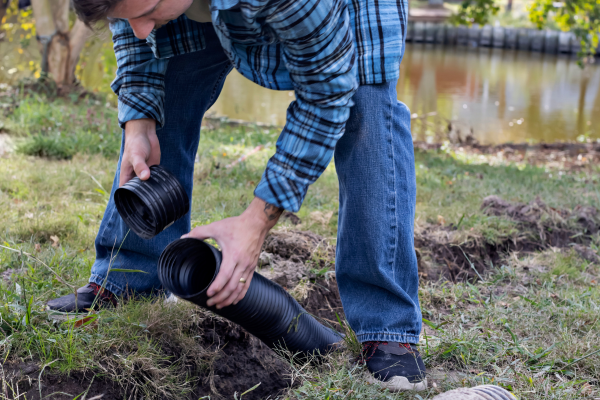French drains provide a relatively easy and cost-effective solution to drainage problems that may result from heavy rain, flooding, and even leaky pipes. AFrench drain basically consists of a slightly sloped trench, with a perforated pipe installed at the bottom and round gravel or crushed stone placed on top of it, to grade. Because water always follows the path of least resistance, any excess water that tends to accumulate in the area where a French drain is installed will seep through the gravel or rock and enter the pipe, flowing away from the home. By improving the drainage around your property, a French drain can considerably reduce the risk of water damage to your home.
While thisdrainage system can prevent water from accumulating around or underneath your foundation, an important thing to know is that not all French drains are created equal. Improperly installed, a French drain could lead to a whole host of issues, ranging from soggy lawn and flooding to soil erosion, mold inside your home, and even severe structural damage.
One way to ensure your French drain will work properly is to be aware of what could go wrong during the installation process. To help, here are the most common French drain installation mistakes we usually find during the foundation inspections we perform.
Installing the French Drain Too Deep
Oftentimes, a shallower French drain is more effective at collecting surface water than a drainage system installed deeper into the ground. If your problem is surface water pooling around your property after heavy rain, the French drain doesn’t have to go very deep as, in that case, its main purpose will be to intercept water runoff and direct it toward a catch basin or specially constructed sump pit.
Failing to Install the French Drain Deep Enough When Required
If you’ve noticed foundation problems that might have been caused by water accumulating in your crawlspace or underneath your home, the trench of theFrench drain must go as deep as the base of your foundation’s footings in order to fix the problem. A French drain that runs around the perimeter of a house at the footing level will intercept and divert any excess underground water that may otherwise reach the foundation’s piers, beams, slab, and underfloor components.
Installing an Exterior Instead of an Interior French Drain
An interior French drain is typically recommended for properties whereregrading the yard to achieve positive drainage is not feasible. Interior French drains are installed underneath homes, at the outer edge of the foundation. Once installed, the drain is generally patched with a thin layer of concrete or covered with tiles, except for a small gap toward the exterior edge of the trench, which will allow water to flow into the gravel and pipe below. Depending on the specifics of your property, an interior French drain can be more effective at keeping your foundation dry than an exterior French drain installed at the footing level.
Failing to Figure Out the Slope
When it comes to water runoff, there are 2 basic facts that shouldn’t be ignored: it always flows downward, and it always follows the path of least resistance. Unfortunately, inexperienced workers can easily overlook these aspects. When the trench of a French drain isn’t steep enough, has dips, or worse, has a negative grade—meaning the slope goes from low to high instead of high to low— the water accumulates inside the trench. In that case, the French drain may draw water instead of draining it away, making things worse for your foundation and home.
Using the Same Type of Pipe Along the Drainage System
If you have trees and shrubs around your property, it’s advisable to replace the perforated pipe with solid pipe in those particular areas. Even though landscape fabric is typically wrapped around the perforated pipe to keep dirt and roots out,no landscape fabric is indestructible. As the fabric deteriorates over time, roots will grow inside the pipe eventually and clog it. Using solid pipe throughout areas with trees and shrubs will keep your French drain in good working condition for longer.
In addition to these mistakes, a few more common mishaps with French drain installation include:
- Not lining the trench with landscape fabric or using the wrongtype of fabric;
- Using the excavated soil to fill the trench, will reduce the capacity of the drain and even clog it completely soon after the installation;
- Using the wrong type of gravel;
- Misdirecting the pipe holes or skipping the drainpipe altogether.
Regardless of whether you need a deep or shallower, an exterior or interior French drain, putting in this type of drainage system isn’t a project for the inexperienced. Rather than risking problems down the road, make sure you have your French drain installed by experienced professionals. At Allied Foundation, our team is ready to assess your property’s drainage issues along with any foundation problems you might have and develop a customized long-term solution that will keep your house in the best shape possible for many more years to come.Contact us today for a free foundation inspection and estimate!



